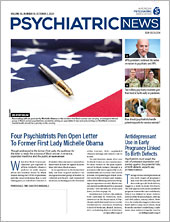The executive summary of a United Nations report on youth and COVID-19 opens with a warning: “[U]nless urgent action is taken, young people are likely to suffer severe and long-lasting impacts from the pandemic.”
The report outlines the findings from the Global Survey on Youth and COVID-19. The survey was conducted between April and May 2020 and includes more than 12,000 responses from 112 countries. “Young people are concerned about the future and their place within it,” the report stated.
As young adults return to college this fall, their school experiences are likely radically different from anything they have experienced before, whether their universities have reopened with in-person or virtual classes.
“College students are dealing with a wide range of issues right now,” said Meera Menon, M.D., chair of APA’s Caucus on College Mental Health and a psychiatrist at Ohio State University’s Counseling and Consultation Service. “They’re still being faced with the most common stressors that college students face like anxiety, depression, academic stress, and relationship stress, but on top of that is this uncertainty caused by the pandemic.”
The staff of college and university mental health counseling programs have had to make decisions on whether to provide students with in-person services based on how their respective campuses are operating, explained Sharon Mitchell, Ph.D., president of the Association for University and College Counseling Center Directors and director of counseling services at the University at Buffalo. If the university has gone completely virtual for the fall semester, so too has the counseling center. If in-person classes are being offered, the decision on whether counseling services are offered in person depends on whether offices offer enough room for staff to meet with students safely. For the most part, however, services are being delivered virtually, she said.
“A lot of it has to do with the logistics and resources on each individual campus,” Mitchell said.
Counseling center staffs will continue to reach out to students about available services, but in a virtual environment. “Email and website communications have become a way of life—that’s how everybody is getting information,” Mitchell said.
As counseling centers work to ensure students are receiving mental health support, the need may be greater than ever. According to a 2018 report from the Center for Collegiate Mental Health at the Pennsylvania State University, the use of college and university counseling centers increased by an average of 30% to 40% between 2009 and 2015 (see
Psychiatric News).
Additionally, a Centers for Disease Control and Prevention (CDC) survey in late June found that individuals aged 18 to 24 are one of the groups disproportionately impacted by mental health conditions due to the pandemic (see
Psychiatric News).
College students are grieving, Menon said. “When you attend college, you expect it to look a certain way. But obviously, their semesters aren’t going to look how they’re expecting because even universities with in-person classes are greatly limiting the size and how they take place.” Many opportunities that students may have looked forward to, such as study abroad trips, social clubs, and sporting events, have been postponed, Menon pointed out.
The many changes schools are making as they respond to the pandemic will likely cause additional stress for students. Some colleges were hoping to reopen under a hybrid model, which is a mix of in-person and virtual classes, but spikes in COVID-19 caused them to go entirely virtual instead. Students may be confronted by frequent changes in how they learn this year, which is yet another stressor they’ll have to deal with, Mitchell said.
Some students who were dealing with anxiety before the pandemic began may have enjoyed their isolation once widespread stay-at-home orders were implemented, said Ludmila Barbosa De Faria, M.D., a member of APA’s Caucus on College Mental Health and a clinical associate professor at the University of Florida Department of Psychiatry. Now, some of those students have had to deal with returning to classes or dorms while the pandemic continues. Moreover, she said, several students have told her that they are thinking of taking a break from college now.
As students grapple with the challenges the pandemic brings, the demand for mental health care, De Faria said, will likely rise. And as universities report financial problems, she worries that mental health support and counseling centers may top the list of areas for potential budget cuts.
De Faria pointed out that the CDC survey showed that 25% of respondents aged 18 to 24 reported having seriously considered suicide in the past 30 days.
One silver lining for college students has been the relaxed rules around telehealth that were implemented shortly after the pandemic began, Menon said. They were especially helpful for college students who cross state lines to attend school. When students couldn’t return to college in the spring, Menon said that she found that the flexibilities made it easier for her to help patients transition to services in different states and offer them a few telehealth sessions during the transition.
De Faria advised anyone who is interacting with college students to ask them how they feel about their current college experiences and what their plan is for self-care. “Students are experiencing everything that’s happening right now in very unique ways,” she said. “They need an open dialogue to talk about what they’re experiencing.” ■
“Youth and COVID-19: Impacts on Jobs, Education, Rights, and Mental Well-Being” is posted
here.

